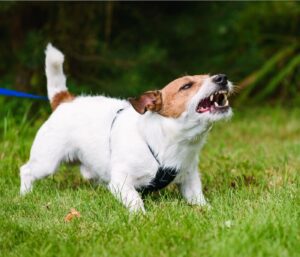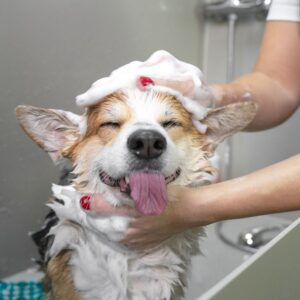Dog scooting is a common behavior among dogs after grooming sessions. It is the act of dragging their hind end on the ground, which is often a sign of discomfort or itchiness in the anal area.
This behavior can be alarming for pet owners, but it is important to understand the reasons behind it.
In this article, we will explore the top 5 reasons for dog scooting after grooming and provide some home remedies that can help alleviate the symptoms.
Whether your dog is experiencing anal gland problems, skin irritation, or an infection, this article will provide valuable information on how to address the issue and keep your dog comfortable.
Understanding the causes of dog scooting and taking proactive measures to treat it can help improve your pet’s quality of life.
With the right care, you can help your furry friend feel better and enjoy a healthy, comfortable life
What Is Dog Scooting?
Dog scooting is a term used to describe the dragging of a dog’s hindquarters or rear end along the ground. It can be accompanied by itching and scratching, which may cause your dog to scratch at its back end with her front paws.
This type of behavior usually develops as a result of an anal gland problem or allergies/infections/parasites/mites—or even pain from any number of other causes (like sore joints).
Dog Scooting After Grooming (5 Reasons)

Anal Glands
The anal glands are located on both sides of the anus, and they produce a secretion that is used to mark territory.
The anal sacs are a part of these glands, so if your dog has impacted or infected anal glands, it may be time to check their health.
If you think your pet has impacted anal sacs – which can be seen as small piles of hair at each side of their rear end – consult with a vet right away before things get worse!
If you do notice any changes in your dog’s regular habits (such as sleeping more than usual), make sure you take them directly to see their vet so that they can investigate further and rule out any serious problems like cancerous tumors or abscesses (the accumulation of pus).
Allergic Reaction
If your dog is allergic to something, it can cause itching and irritation in the anal area.
This can lead to scratching, licking and biting the skin. The skin may become red and inflamed (inflammation).
It’s Important to know that there are many different things that could be causing your dog’s anal discomfort so talk to a veterinarian if you don’t know what the problem is.
Infection or Inflammation
If you’ve had your dog groomed and he’s scooting, it could be an infection or inflammation based on the cause of the scoot.
Infections can be caused by bacteria or yeast, parasites (like fleas), mites (like ticks) and food allergies. Environmental allergies are another possibility that should be considered as well.
Pain or Discomfort
Pain or discomfort is a common reason for scooting. It may be caused by anal glands, allergy, infection, inflammation and parasites.
Pain can also be caused by grooming (too much pressure on the area) or diet (a change in food).
Medical attention is necessary if you notice any type of pain after grooming your dog’s face or neck area.
Parasites and Mites
Parasites and mites are common in dogs. They can cause dog scooting, but they’re not life threatening.
Parasitic infestations are easily treated with medication, so if your dog is scratching a lot it may be worth checking with your veterinarian to see if you need to take them off the street for a few days until they’re cleared up.
Home Remedies for Dog Scooting After Grooming:

If your dog has scooting issues, you may want to try these home remedies.
Take it easy on the dog’s paws. If he’s been spending a lot of time outside, he may be more sore than usual.
If this is the case, give him a rest from intense exercise for a few days or until his wounds have healed.
Apply ice cubes wrapped in gauze pads to the affected area for 10 minutes at a time every hour or two for up-to-two days (or longer).
This will help reduce swelling and pain while allowing healing time to occur naturally without further irritation from cold or compression around sensitive tissues like tendons or bones.
You can also use an electric heating pad set below body temperature (about 100 degrees Fahrenheit) instead of applying direct heat if necessary because both methods work equally well at reducing swelling without causing additional damage to tissue; however there isn’t much difference between how long it takes either method so if one works better stick with it!
Keeping the Anal Area Clean
Keeping the anal area clean is an important aspect of preventing dog scooting. Regular cleaning can help remove any dirt, debris, or excrement that may be causing discomfort. Some steps to keep the anal area clean include:
- Gently wiping the area with a damp cloth after every bowel movement
- Trimming any hair in the area to prevent matting and minimize the risk of infections
- Washing the area with a gentle, hypoallergenic solution during baths
- Using a soft, moisture-absorbing powder to prevent moisture buildup and reduce the risk of skin irritation.
It is important to handle the anal area gently and avoid using any harsh chemicals or scented products, as these can further irritate the skin.
Regular cleaning and monitoring of the anal area can help prevent scooting and ensure that your dog remains comfortable and healthy.
Using a Warm Compress
Use a warm compress to help with the pain. You can do this by putting a warm, wet washcloth on the area.
You can also use a heating pad or warm water bottle if you have one at home. If not, most stores sell them now!
Or try using hot compresses for dogs that have been through SDA’s grooming process (Sterilization & Docking).
This will help with any swelling and pain after surgery as well as speed up healing time so they don’t feel as much discomfort during their recovery process.
Applying a Healing Ointment
If your dog is itching, applying a healing ointment is an easy way to help relieve the irritation.
Healing ointments are available at your vet or pet store and should be applied directly to the irritated area.
They come in many different forms—some contain natural ingredients that soothe the skin while others contain medications such as benzoyl peroxide (which can cause allergic reactions).
Healing ointments should be applied 2-3 times daily until you see improvement in your dog’s symptoms.
Adjusting the Diet
After a bath, your dog’s fur needs to be groomed and it’s also a good time to make sure you’re feeding them something nutritious and balanced.
A high fiber diet is best for dogs with sensitive skin or digestive issues, so try switching over to one that is low in fat or sugar content (no hot dogs!).
You can also reduce the amount of meat in their meals if they are overweight. Your veterinarian may recommend other dietary changes based on their symptoms as well
Seeking Medical Attention
If you see your dog scooting, it is important to find out why. If you have any questions or concerns about the behavior, contact your veterinarian as soon as possible.
Your vet will be able to determine if there is an underlying medical problem that could be causing the scooting and what steps can be taken to treat it.
If your dog is exhibiting this behavior for more than a few days without improvement, seek medical attention immediately!
Reducing the risk of scooting:
You can use the following techniques for grooming your dog to keep them occupied and reduce the risk of scooting.
Hide treats in new places around the house, or create a game where you hide treats and then let your dog find them. This will help keep their minds sharp while they’re getting groomed!
If you have an older dog with arthritis, consider using a harness and lead instead of forcing them into the car during grooming time (you may want to check out our article on how to choose the best harnesses).
If possible, try clipping him/her into one area so that he/she doesn’t feel insecure about moving around too much when you’re doing his/her nails or teeth cleaning—this way he/she won’t get scared by being trapped in one place for too long!
FAQs:
Q: When should I take my dog to the vet for scooting?
A: It is recommended to take your dog to the vet if the scooting becomes severe or persistent, as it may be a sign of a more serious underlying issue. Your vet can diagnose the cause of the scooting and provide the appropriate treatment.
Q: Is dog scooting a normal behavior?
A: While scooting is a common behavior among dogs, it is not considered normal and may indicate an underlying issue that needs to be addressed.
Q: Can dog scooting lead to other health problems?
A: If left untreated, dog scooting can lead to further skin irritation, infections, and even discomfort or pain for the dog. It is important to address the issue promptly to prevent any further health problems.
Q: Can diet affect dog scooting?
A: Yes, diet can affect dog scooting. An improper diet that lacks essential nutrients or includes ingredients that are not easily digestible can cause digestive problems, leading to scooting.
Q: How often should I check my dog’s anal area?
A: It is recommended to check your dog’s anal area regularly, especially after grooming sessions or when noticing any signs of scooting. Regular cleaning and monitoring can help prevent any potential issues from developing.
Q: Can dog scooting be treated with medication?
A: Yes, dog scooting can be treated with medication, including antibiotics for infections, anti-inflammatory drugs for skin irritation, and medications for parasitic infestations. Your vet can recommend the appropriate medication for your dog’s specific needs.




